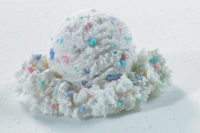The history of frozen desserts is marked by many significant scientific and technical innovations and advancements that make the products we produce more appealing, more convenient, nutritionally more efficacious and less costly.
Here is our annual review of what’s new, what’s not-so-new and what’s truly innovative in terms of approaches, product positioning, ingredients, composition and formulation, and other factors.
- Low- and no- sugar frozen desserts.The list includes no-sugar-added (NSA) products, NSA without high-intensity sweeteners, true sugar-free frozen desserts and simply lactose reduction for lactose-free or protection from the rigors of heat shock (e.g., sandiness).
- Calorically modified frozen desserts. We covered this in our column of April 2013. By taking novel approaches and using new ingredient tools, we can drive the caloric density of frozen desserts down to attractive levels not before possible.
- “Greek” frozen yogurt and other hybrid products. There always seems to be both opportunity and curse with varying degrees of technical achievement. We touched on “Greek” frozen yogurts and hybrid products previously.
- High-intensity sweeteners in conventional ice cream. The concept of cost per unit sweetness drives this application. Beyond low- and no-sugar products, the ultra-low sweetening cost of many high-intensity sweeteners not only allows for possible sugar-modified products but less expensive ones at that.
- Novel dairy ingredients. In the past, composition and pre-treatment of dairy ingredients has offered novel functionalities (water control, emulsification, etc). However, new is the availability and utility of ultra-low (i.e., “cold”) temperature processed dairy ingredients, preserving native functionalities such as ultra-low viscosities, while separating various fractions for the ever-growing demand of higher-protein frozen desserts, like Greek frozen yogurt above.
- Unsaturated fats/oils. Not immediately obvious is the use of unsaturated fats/oils with added functional utility. Recent studies add to the knowledge of how these fats/oils function under conditions of use, mix processing, hardening, storage and distribution, and help provide physical strength to the structure of finished products. It’s a new look at an old “problem.”
- Whole algalin flour. A new, exciting raw material from the controlled growth of algae offers the potential for both water-control properties and emulsification potential. Based on its composition, including the complexity of its lipid fractions (see unsaturated fats/oils), the utility of whole algalin flour indicates some highly promising, but as yet not totally vetted (nor totally understood) functionality.
- Low-viscosity polysaccharides as “stabilizers.” Similar to the potential of unsaturated fats/oils, it is not intuitively obvious that low-viscosity polysaccharides can be functional in frozen desserts. However, in recent work, the utility of select low-viscosity polysaccharides to provide additive features and benefits beyond what such ingredients were initially intended is compelling.
- Water control index (WCI). This is a novel approach to weigh the ability of individual ingredients to control water mobility, thus managing the growth of ice crystals during distribution and storage. When considered with other similar indexes (freezing point, sweetness, etc.), WCI can be a significant tool.
- New use of cryogenically frozen ice cream. The use of cryogenic fluids to ultra-fast-freeze ice cream mix for immediate consumption is growing at the retail shop level. Can packaged ice cream be far behind?
- Mix processing, whipping/freezing. We are talking about vacuum mixing to reduce undesirable foaming during mix making, plus, some interesting utility of ultra-low-viscosity mixes (see ultra-low viscosity polysaccharides above).
For further study:
- Learn more about the evolving new technologies at “Tharp & Young on Ice Cream: Technical Short Course, Workshops, and Clinics,” Dec. 4 to 6, in Las Vegas.
- Purchase the new reference text, “Tharp & Young on Ice Cream: An Encyclopedic Guide to Ice Cream Science and Technology.”
- Listen to the Tharp and Young webinar “Ice Cream & Frozen Desserts: Formulating & Processing for Success. www.dairyfoods.com/events/category/2141
- To register for the short course, or to purchase the book, go to www.onicecream.com or call 610-975-4424 or 281-782-4536. The book is also available from the Dairy Foods Store.







